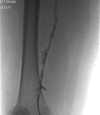Deep vein thrombosis: pathogenesis, diagnosis, and medical management
- PMID: 29399531
- PMCID: PMC5778510
- DOI: 10.21037/cdt.2017.09.01
Deep vein thrombosis: pathogenesis, diagnosis, and medical management
Abstract
Deep vein thrombosis (DVT) is a major preventable cause of morbidity and mortality worldwide. Venous thromboembolism (VTE), which includes DVT and pulmonary embolism (PE), affects an estimated 1 per 1,000 people and contributes to 60,000-100,000 deaths annually. Normal blood physiology hinges on a delicate balance between pro- and anti-coagulant factors. Virchow's Triad distills the multitude of risk factors for DVT into three basic elements favoring thrombus formation: venous stasis, vascular injury, and hypercoagulability. Clinical, biochemical, and radiological tests are used to increase the sensitivity and specificity for diagnosing DVT. Anticoagulation therapy is essential for the treatment of DVT. With few exceptions, the standard therapy for DVT has been vitamin K-antagonists (VKAs) such as warfarin with heparin or fractionated heparin bridging. More recently, a number of large-scale clinical trials have validated the use of direct oral anticoagulants (DOACs) in place of warfarin in select cases. In this review, we summarize the pathogenesis, diagnosis, and medical management of DVT, with particular emphasis on anticoagulation therapy and the role of DOACs in the current treatment algorithm.
Keywords: Deep vein thrombosis (DVT); anticoagulants; direct oral anticoagulants (DOACs); vitamin K-antagonists (VKAs); warfarin.
Conflict of interest statement
Conflicts of Interest: The authors have no conflicts of interest to declare.
Figures




References
Publication types
Grants and funding
LinkOut - more resources
Full Text Sources
Other Literature Sources
